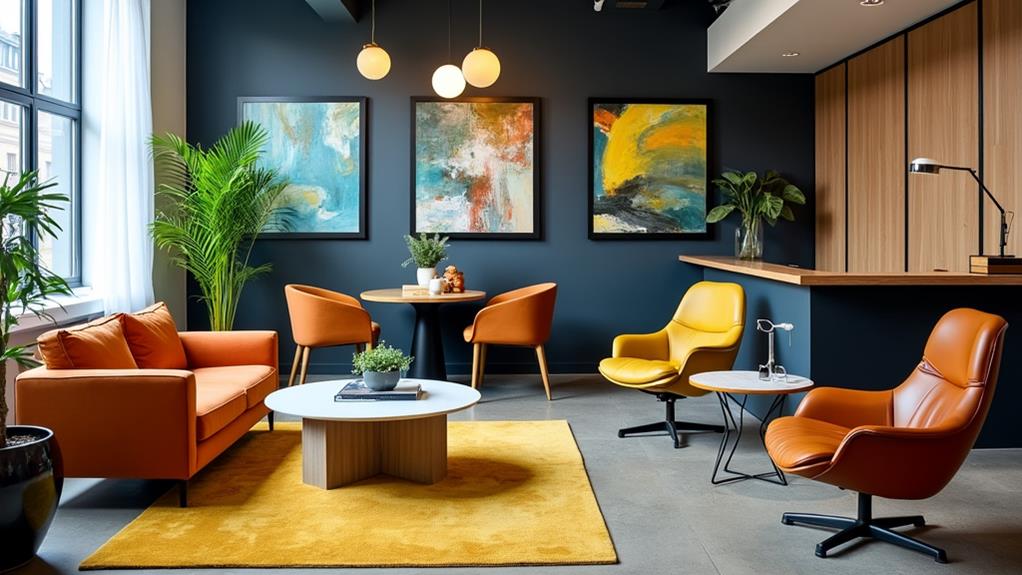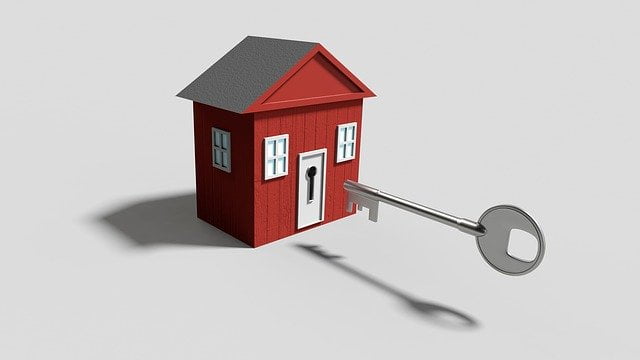Deciding whether to lease or buy commercial furniture involves strategic financial and design considerations. Leasing spreads costs over time and offers flexibility with lower upfront expenses, plus potential tax benefits through deductible lease payments. It adapts to changing space needs and often includes maintenance. Buying, however, requires significant initial investment but provides long-term cost-effectiveness, depreciation benefits, and allows control over design and maintenance. Ownership adds value to your balance sheet and can enhance brand consistency. Analyze your budget, strategic goals, and total cost impacts to guarantee this decision aligns with your business’s needs. Explore further to make an informed choice.
Financial Impact
Evaluating the financial impact of leasing versus buying commercial furniture is vital for any business seeking to optimize its resources.
When you lease, you’ll typically experience a more manageable cash flow, as costs are spread over time. This approach allows you to allocate funds to other significant areas of your business, guaranteeing financial stability and safety. By leasing, you can also avoid large upfront expenditures, which can be particularly beneficial if your budget considerations are tight.
In contrast, buying furniture outright requires a substantial initial investment. This can strain your cash flow, especially if your business is in its early stages or undergoing rapid growth.
However, owning furniture can be advantageous in the long run, as it becomes an asset on your balance sheet. Ownership might also offer depreciation benefits, which could positively affect your financial statements.
Ultimately, your decision should hinge on a careful assessment of your current budget considerations and long-term strategic goals.
Whether you choose to lease or buy, maintaining a safe financial position is essential. Consider consulting with a financial advisor to guarantee your choice aligns with your business’s cash flow needs and budgetary constraints.
Flexibility and Adaptability
Flexibility is a key factor when deciding between leasing and buying commercial furniture. Leasing offers a dynamic approach, allowing you to adapt quickly to changing space requirements and trends without the long-term commitment. This option is particularly beneficial for businesses that experience frequent layout changes or need to scale operations swiftly.
With leasing, you gain access to a broader range of customization options, guaranteeing your workspace remains both functional and aesthetically pleasing.
Buying, on the other hand, provides stability and permanence. When you choose to purchase, you have the freedom to make long-term design decisions and invest in high-quality pieces that reflect your brand’s identity. This option suits businesses with stable space requirements, minimizing the need for frequent updates.
However, it may limit your ability to pivot swiftly in response to evolving needs.
Here are some factors to take into account:
- Leasing allows for quick adaptation to space changes.
- Ownership guarantees full control over customization options.
- Leased furniture often includes maintenance and upgrade options.
- Purchased furniture can offer long-term safety and durability.
- Leasing helps maintain cash flow flexibility for other investments.
Ultimately, your decision should align with your business’s flexibility and adaptability needs.
Upfront Costs
When it comes to upfront costs, both leasing and buying commercial furniture present distinct financial considerations that can impact your business’s budget and cash flow.
If you choose to buy, the initial investment is typically higher as you need to purchase the furniture outright. This option might strain your cash flow, especially for startups or businesses looking to expand rapidly. However, owning furniture outright means that, over time, you might find it a more cost-effective solution as you won’t be tied to ongoing payments.
On the other hand, leasing commercial furniture generally requires lower upfront costs, which can ease the immediate financial burden on your business. This approach can help maintain a healthier cash flow, allowing you to allocate funds to other critical areas such as safety enhancements or marketing strategies.
Leasing often provides access to higher-quality pieces without the need for a significant initial investment, aligning with industry-specific design aspirations.
Ultimately, the choice between leasing and buying depends on your business’s financial strategy and long-term goals.
Weighing the immediate impact on your cash flow against the potential long-term benefits of ownership can guide you in making a decision that best supports your design vision and budgetary constraints.
Maintenance Responsibilities
Managing maintenance responsibilities is a crucial aspect when deciding between leasing or buying commercial furniture. When you lease, the maintenance of furniture often falls on the leasing company, which can alleviate your concerns about unexpected repair costs. This approach can guarantee that furniture remains durable and functional without additional expenses on your part.
Conversely, when purchasing furniture, you’re responsible for maintenance and any associated costs. This can lead to unforeseen expenses if the furniture doesn’t hold up as expected, raising durability concerns.
Here are some factors to reflect on regarding maintenance responsibilities:
- Leasing Agreements: Often include maintenance services, reducing your burden.
- Durability Assurance: Leased items might be regularly updated or replaced, guaranteeing high standards.
- Cost Predictability: Leasing can offer fixed maintenance costs, aiding budget planning.
- Ownership Control: Buying allows for full control over maintenance schedules and methods.
- Long-term Investment: Purchased furniture might require more attention over time, impacting maintenance budgets.
Ultimately, your decision should align with your business’s operational needs and long-term goals.
Prioritizing safety and functionality guarantees that your workspace remains conducive to productivity. Evaluate these factors carefully to choose a path that supports both your business’s aesthetic and financial objectives.
Tax Implications
Considering maintenance responsibilities can greatly impact your choice between leasing and buying commercial furniture, but it’s equally important to evaluate the tax implications of each option.
In the design-focused industry, understanding how each choice affects your financial statements is vital for making informed decisions.
When you buy furniture, you can capitalize on depreciation benefits. Over time, you can depreciate the cost of the furniture, which reduces your taxable income. This provides a long-term tax advantage, making ownership appealing if you plan to keep the furniture for several years.
However, the upfront cost can be significant, requiring careful budget planning.
Leasing, on the other hand, offers immediate tax deductions. Lease payments are typically considered a business expense, allowing you to deduct them from your taxable income as they’re incurred. This can provide a more immediate financial relief compared to the gradual depreciation of purchased assets.
Additionally, leasing often requires a lower initial outlay, enhancing cash flow safety.
Ultimately, your decision should align with your business’s financial strategy and tax planning. Consulting a tax professional can help you navigate these considerations, ensuring that your choice supports both your design goals and fiscal health.
Furniture Ownership
Owning commercial furniture doesn’t just provide tangible assets for your business; it anchors your brand’s aesthetic and identity. When you choose to own, you’re investing in pieces that reflect your company’s values and ethos, offering a consistent and stable environment for employees and clients alike.
The furniture lifespan becomes a critical factor, as durable, high-quality items can serve your business for years, reducing frequent replacements and associated costs.
Ownership benefits extend beyond aesthetics and longevity. Here are several key advantages:
- Asset Value: Furniture ownership adds tangible assets to your balance sheet, enhancing your company’s financial profile.
- Customization: Tailor furniture to meet specific design and functional requirements, guaranteeing ideal workspace solutions.
- Control: Exercise full ownership rights, which means no restrictions imposed by leasing contracts.
- Depreciation Deductions: Benefit from potential tax advantages through depreciation of owned assets.
- Long-term Savings: While upfront costs may be higher, ownership can lead to financial savings over time compared to continuous leasing fees.
Investing in furniture ownership provides security, stability, and a strategic advantage, reinforcing the integrity of your brand’s environment.
Prioritizing both quality and safety guarantees your commercial space remains a reliable foundation for your business’s growth.
Design and Trend Updates
Staying informed about design and trend updates in commercial furniture is essential for maintaining a modern and appealing workspace. As an industry professional, you need to prioritize both aesthetics and functionality to guarantee a productive and safe environment.
The latest trends emphasize ergonomic features designed to enhance comfort and reduce the risk of workplace injuries. By choosing furniture with adjustable elements, you can cater to diverse needs and create an inclusive space that promotes well-being.
Sustainable materials are also at the forefront of current design trends. Opting for furniture crafted from eco-friendly resources not only aligns with environmental responsibilities but also often results in durable products. This choice reflects your commitment to sustainability and can improve your company’s reputation among eco-conscious clients and employees.
When considering whether to lease or buy, staying updated with these trends offers flexibility. Leasing allows you to adapt rapidly to new designs, guaranteeing your space remains contemporary without the long-term commitment.
Conversely, buying provides stability in design but requires careful selection to ensure long-term relevance and safety. Ultimately, integrating ergonomic features and sustainable materials into your commercial furniture solutions will help you maintain a stylish, safe, and responsible workspace.
Contractual Obligations
When steering through the domain of commercial furniture, understanding contractual obligations is essential for making informed decisions.
Whether you’re leaning towards leasing or buying, both options come with distinct responsibilities that can impact your business’s flexibility and finances. Lease terms often provide a structured yet flexible approach, allowing you to refresh your furniture as styles evolve. However, they may also include restrictions that you need to adhere to, guaranteeing the longevity and condition of the items.
Purchase agreements, on the other hand, involve a more permanent commitment, offering full ownership but requiring significant upfront investment. This route allows for customization and long-term stability but doesn’t offer the opportunity to easily update pieces without additional expense.
In considering these options, pay attention to:
- Duration: Lease terms typically range from one to five years, while purchases are indefinite.
- Maintenance: Leases might include maintenance, whereas purchases require self-management.
- Exit Clauses: Confirm there’s a clear understanding of termination fees or penalties.
- Financial Impact: Examine the total cost of ownership versus leasing over time.
- Customization: Ownership allows for modifications; leases might not.
Long-term Value
As you evaluate the contractual obligations of leasing and buying commercial furniture, consider the long-term value each option brings to your business.
When purchasing furniture, you have the advantage of ownership, which directly influences the resale value. High-quality pieces may retain value over time, offering potential returns if you decide to sell. However, be mindful of depreciation considerations. Furniture, like any asset, will lose value as it ages, and styles can become outdated, affecting its appeal and safety standards.
Leasing, on the other hand, allows you to maintain modern and up-to-date furnishings without the burden of ownership. This option often includes maintenance and upgrades, ensuring that your workspace remains stylish and safe without the added cost of depreciation. While you won’t benefit from resale value, leasing provides flexibility to adapt to changing design needs or business expansions.
Ultimately, the decision hinges on your business’s specific needs and long-term strategy. If maintaining a cutting-edge environment is essential, leasing offers a viable solution. Conversely, if you prefer the potential financial return through resale and can manage depreciation, buying might be the better choice.
Carefully weigh these factors to align with your business’s safety and design priorities.
Conclusion
In deciding between leasing or buying commercial furniture, weigh the scales of flexibility against ownership. Leasing offers adaptability and lower upfront costs, but buying grants you control and long-term value. Like choosing between fleeting trends and timeless designs, your decision should reflect your business’s unique needs. Consider maintenance responsibilities, tax benefits, and contractual obligations carefully. Ultimately, the choice shapes your workspace’s future, blending financial savvy with design foresight—where form meets function, and strategy meets style.




